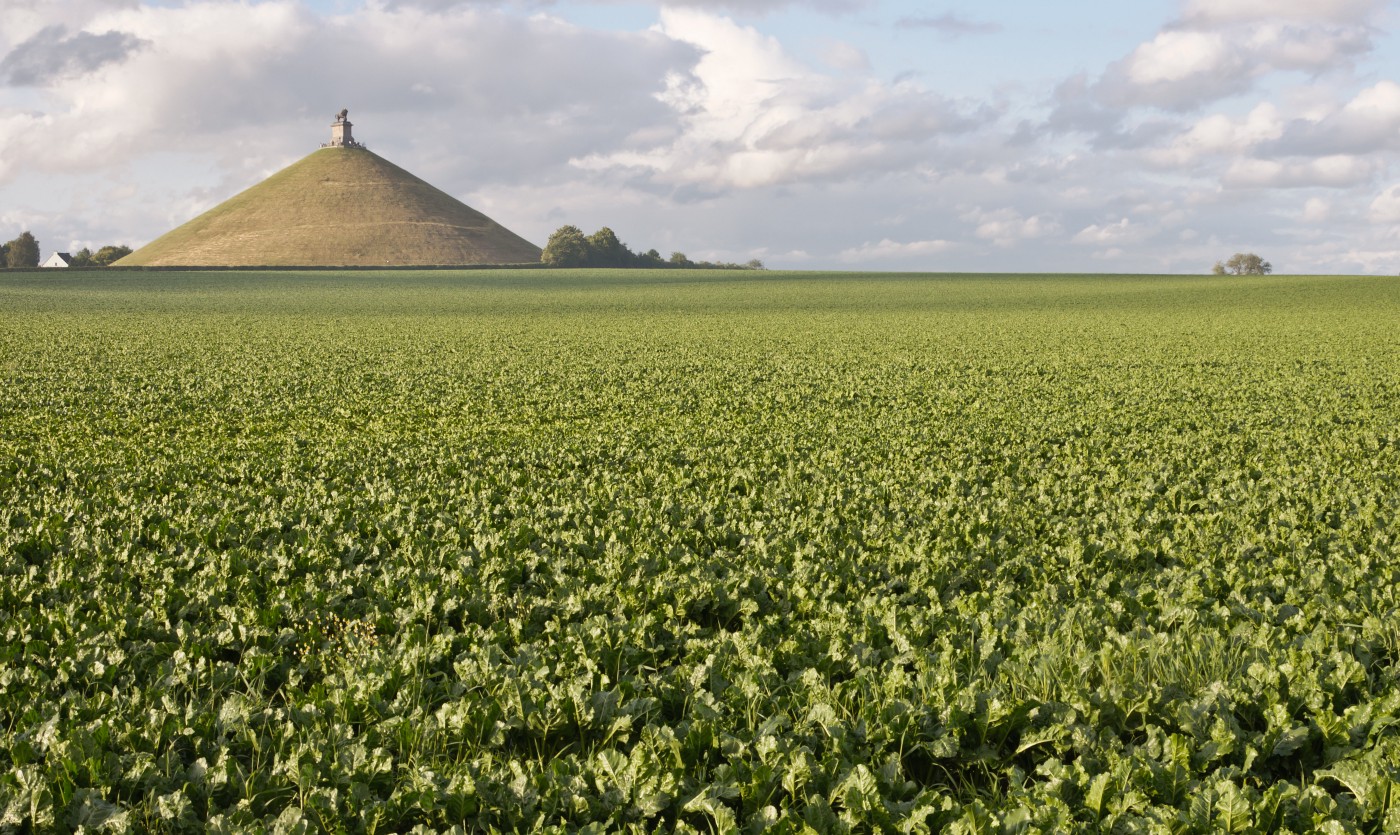Mass graves and hominid hugelkultur enabled agriculture and a new market economy. Tue 04 January 2022

Waterloo battlefield was scraped to create Butte du Lion, the Lion's Mound. Source
The battlefields of Waterloo were scraped into a vast cone five years after Napoleon's 1820 defeat. On completion in 1825, Butte du Lion stood 43m high.
1825 construction of Butte du Lion. Source
From What happened to the bones of Waterloo?:
The curious thing about the history of the Battle of Waterloo is that archaeologists have discovered only two human skeletons at the battlefield even though tens of thousands of men and 7000 horses died. Contemporary accounts describe mass burials and cremations. What happened to the corpses?

Sugar beet factory near Butte du Lion. Source
Some of the bones went to a Belgian sugar beet factory built three miles away, where they were used to help refine white sugar. Most were shipped to Hull, England, for grinding into phosphate fertilizer, then sold in Doncaster. 1
But the bones were only collected up after a period of rotting in shallow graves.
From These spots of excavation tell: using early visitor accounts to map the missing graves of waterloo:
Near this place (La Haye Sainte) on the opposite side of the road is a hollow way, where 4,000 men besides horses were buried. On passing this spot in May 1816 the corn was growing on the ground in the most luxuriant manner (Romberg’s guide book, 1816).
The very morning after the battle, the peasants were ordered to bury the dead, and when the Duke of Richmond rode over the field on Wednesday morning all the bodies have been already stripped and plundered. This part of the ceremony was performed by the fairer sex. The most valuable part of the soldier’s dress to the plunderers were shoes and stockings, which of course they made great haste to lay hold of... (Jennings 1884, 74)
By nine o’clock, on the Monday morning, the peasantry had stripped the whole of the dead who were lying naked in heaps. I learnt from a gentleman who visited the spot about that hour, that he only saw one English officer who had any clothes left on (Smithers 1820, 249).
Five years later, farmers stripped 30cm of their fertile top soil for their own use, sold the rest for building Butte de Lion:

'Les botresses' carried clay and bricks to the top of mound in 1826. Source The Lion’s Mound with Alain Lacroix
And this may explain a feature of Britain's 'prehistoric' mounds: their fertile soil.
From On Celtic Tumuli in East Kent, CH Woodruff, Archaeologia Cantiana, Vol 9, 1874, p17:
The rich, unctuous soil of which these barrows are often composed, forming a good manure, has given an additional motive for levelling what is always an obstruction to tillage.
Woodruff notes that Kent farmers robbed the mounds for their fertile soil, leaving few to excavate.
Why would 'the ancients' use good quality agrictural soil to build commemorative mounds?
They didn't. They made good agricultural soil as a by-product of killing and butchery.
From Moot Hills: Mounds were sometimes called 'butts'. As in: 'target practice' for archers. The high corpse count in the mounds of England - and beyond - suggests becoming target practice was a commonplace, if once-in-a-lifetime, event:
Jaguar Paw stumbles across his neighbours. Source: Apocalypto (2014)
The new appearance of so many new-looking mounds in 17th Century Britain suggests they were left overs of clean up after the so-called 'Civil War'.
Same in America:
From Cahokia, Illinois:
- A mass grave of more than 50 women around 21 years old, with the bodies arranged in two layers separated by matting (suggests clean up with matting as a temporary fly cover or addition of carbon source to offset nitrogen source)
- A mass burial containing 40 men and women who appear to have been violently killed, some of these may have been buried alive: "From the vertical position of some of the fingers, which appear to have been digging in the sand, it is apparent that not all of the victims were dead when they were interred – that some had been trying to pull themselves out of the mass of bodies."
Cahokia's Monks Mound was so named because French monks farmed it. It was good, fertile, good soil.
And the same went for mounds near Milan. Ohio.
From History of Huron and Erie Counties (Ohio), W. W. Williams, 1879 via Giants and Ancient North American Warfare:
Near these forts were mounds or hillocks, which were found to contain human bones, promiscuously thrown together as if a large number of bodies had been buried at one time. The skull bones, when found entire, were shown by measurement to be larger, upon the average, and all exhibited marks that would indicate that life had been taken in deadly combat.
It's as if clean-up teams collected up bodies created by the Reformatting and carefully layered them under neat mounds of soil. Humus production facilities left ready and rotting for a new generation of farmers.
Battlefield mounds
© All rights reserved. The original author retains ownership and rights.
More of this investigation:
Fingerprints of the Clean Up Team,
More of this investigation:
The Reformation was a Reformatting
More by tag:
#mounds, #giants
